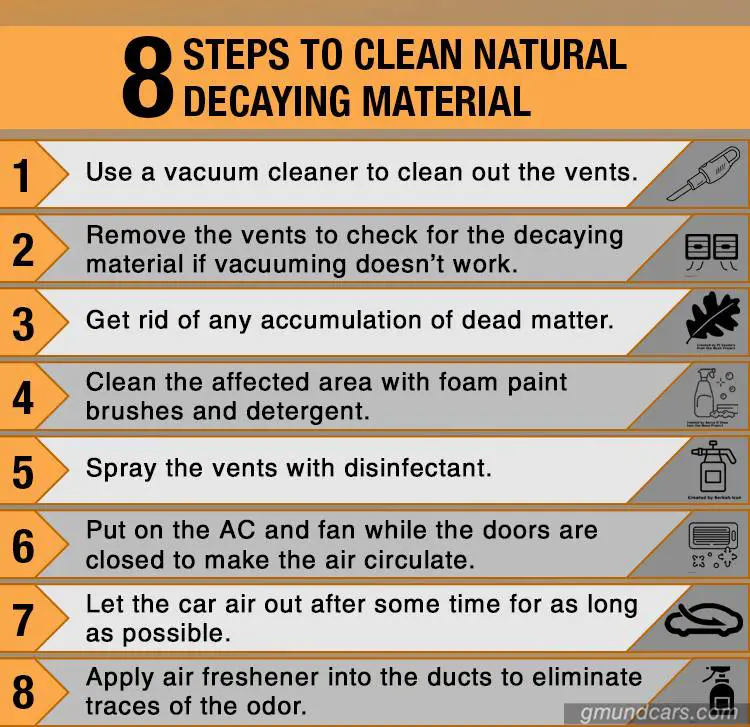Car Ac Smells Funny When First Start It Up
How do you get rid of that unpleasant vinegar-like smell coming through the vents of your car AC?
This post will tell you why your car AC smells like vinegar and how to fix it.
You will be having an odor-free cabin in no time once you follow the tips described in this guide.

Contents
- 1 What should i do if my car AC smells like vinegar?
- 2 Top 4 causes and how to get rid of the vinegar smell
- 2.1 Mold/mildew buildup
- 2.2 Natural decaying material
- 2.3 Emitting ozone in electric air conditioner motor
- 2.4 Bad air conditioner filter
- 3 The other AC smell problems
- 3.1 Rotten egg
- 3.2 Dirty gym socks
- 3.3 Burning rubber
- 3.4 Burning plastic
- 3.5 Maple syrup
- 4 How much will it cost if i fix it in the car repair shop?
- 5 Conclusion
What should i do if my car AC smells like vinegar?
You may notice that the odor gets stronger each time the car air conditioner is on. You can ascertain this by turning the unit off to observe whether the stench will linger or not. Checking the AC vent may be a step in the right direction if the smell ceases after switching the unit off. Double-check by driving around without operating the AC.

The first thing that should come to your mind in such a situation is deciding whether or not to visit an auto repair shop. Try to find out the cause of the vinegary odor and how serious it is on your own. You would be to contact a mechanic/technician to examine the AC for the root of the problem if you can't figure it out.
Tackle the problem if you have adequate DIY knowledge and experience or if its solution is easy to implement. If not, hire a professional ASAP. The expert will take the proper steps in investigating the matter and cautiously tackling the situation without turning the car into a health hazard for you.
Top 4 causes and how to get rid of the vinegar smell
Some car owners assume that the sour odor coming through the air conditioning vents results from vinegar. However, that isn't usually the case. We have described four possible causes in this section.

Mold/mildew buildup
Two of the typical culprits are mold and mildew. They can form in the vents of your car and are caused by several factors such as moisture, dirt, dust, and leaves that accumulate in the vents over time.
Prolonged periods of vehicle disuse can cause these agents to collect on the evaporator fins and coil. AC systems produce condensation, which can be sufficient enough to cause mold or mildew to grow if it doesn't dry totally.
The AC should be examined if the need for a filter change becomes frequent, the AC breaks down often, or the car battery gets drained unusually. Those signs may be pointing towards an accumulation of mold or mildew (maybe a combination of both).
Mold and mildew are types of fungus. So when the technician says there is a fungus in the vents, it may be either of the two or a combination of both. According to a study on fungal colonization of automobile air conditioning systems, the fungi species that can contaminate automobiles include Penicillium, Acremonium, Alternaria, Cladosporium, Aspergillus, etc.
Mold can be identified by its flat or fuzzy appearance with wet, slimy, or powdery forms. Its color could be blue, black, brown, gray, white, green, or yellow. There is a type called black mold, which car owners should seriously consider if they see it on any surface. On the other hand, mildew has a flat growth and can appear powdery or fluffy. Its possible initial colorations include white, gray, or yellow. But these colors will turn black or brown later on.
How to fix
You can see how the two organisms are similar and can be mistaken for each other. Nevertheless, neither of the two should be taken for granted when noticed. It is best to let an expert in car mold and mildew removal handle the inspection and cleaning because of the health hazards, especially cabin air pollution by mold spores.
However, you can handle the decontamination independently if you have the right cleaning equipment, protective gear (e.g. gloves and nose masks), and enough experience. Take the following steps:

- Step 1: Get a Disinfectant
Buy a disinfectant aerosol spray that can kill mold and mildew, such as Lysol. It is best to use a specialty spray (e.g. specialty duct cleaner). You can also use an EPA-approved, hospital-grade disinfectant that can wipe out every trace of the two odor-causing agents.
- Step 2: Ensure that the AC, Fan, and the Car Are Switched off
You need to do these before applying disinfectant into the vents.
- Step 3: Apply the Disinfectant
Spray the disinfectant into all the vents, including the ones at the driver's seat, passenger seat, backseat, dashboard, and rear windshield. Make sure every door is closed during this step.
- Step 4: Put Car, AC, and Fan on
Make sure the AC and fan are working at full power so that the air with the disinfectant is well-circulated around the AC system.
- Step 5: Spray the Disinfectant into the Re-Circulation Vent
Check your car's manual for the location of the re-circulation vent. It can be near the console, on the driver's side floor, or in the trunk. Press the vent's little button (with arrows indicating a circle) if the vehicle has it. This action will make your car stop taking air from outside and recycle the internal air. It would be best to spray the disinfectant into the vent while the AC is still running.
- Step 6: Switch to Full Fan Mode
This step involves switching the AC from "max" to full fan mode to avoid cooling the air further. You would want to be blowing ordinary air instead.
- Step 7: Lift the Hood, Change the Cabin Air Filter, and Apply Disinfectant to all the Intake Lines
These are done for serious mold/mildew buildup situations.
- Step 8: Open the Doors, Run the Vehicle, Switch the AC off, and Let the Fans Work at Full Power
This is the last step in drying out the system. The fans should operate at full power for 5 minutes.
- Step 9: Take Preventive Measures
Get the air conditioner checked and cleaned periodically.
Moisture or water vapor content in cars should be tackled with a dehumidifier.
Condensation can be reduced by sealing leaky areas with EPA-approved sealants, cleaning the drip pans regularly, and insulating the air ducts.
You can also use the fan to dry out the air conditioning system. Do this by switching the AC off and then leaving the fan open on high for about 10 minutes. Carry out the task before turning the vehicle's engine off or parking. Some carmakers have included the After-Blow functionality in their recent models to perform this operation automatically.
Natural decaying material

The cause of that acidic smell might be a buildup of natural material decaying in or around the vehicle's vents or AC. Accumulated plant or animal matter can decompose, ferment, and turn into alcohol with the aid of water droplets formed in the HVAC system. It will then become somewhat sour and start giving off a vinegary stink. The AC will blow the stench into the cabin. Look out for decaying dead animals or plants, food leftovers, or other organic materials.
How to fix
The great journey will lessen when the matter has decayed well enough. But you can't leave it untouched, can you? Wear your gloves, and nose masks, then follow the steps outlined below to get rid of the source of the smell.

- Step 1: Use a vacuum cleaner to clean out the vents.
- Step 2: Remove the vents to check for the decaying material if vacuuming doesn't work. It could be animal remains, dead plant matter, or debris.
- Step 3: Get rid of any accumulation of dead matter.
- Step 4: Clean the affected area with foam paint brushes and detergent.
- Step 5: Spray the vents with disinfectant.
- Step 6: Put on the AC and fan while the doors are closed to make the air circulate.
- Step 7: Let the car air out after some time for as long as possible.
- Step 8: Apply air freshener into the ducts to eliminate traces of the odor.
Read more: How To Vacuum Car AC System Without Pump
Emitting ozone in electric air conditioner motor
A car's AC lets ozone emissions into the cabin because it uses the air outside. Deodorizing or cleaning your vehicle with ozone shock treatments (utilizing an ozone generator) can also cause the scent to linger for days.
Ozone produced by an electric AC motor in an EV (electric vehicle) can have a sour smell, especially in combination with other possible sources of vinegar-like odor. It may also be a pleasant scent. ICE (internal combustion engine) vehicles (diesel, gasoline, and LPG, gasoline) can also emit ozone. Please don't be tempted to keep enjoying the smell because too much of it can harm one's health. Ozone at ground level is toxic to humans, animals, and the environment.
Steps to fix
Getting rid of this smell is simple with the steps below.
- Step 1: Air out Your Car
Keep the windows open for a few hours. Should do it daily until the scent is no longer noticeable. You will stop smelling ozone after a few days.
- Step 2: Drive Around for Some Minutes
Take the car for a drive each day with the windows open. Doing this will make the method more effective and yield quicker results.
Bad air conditioner filter

Credit: cars.com
A defective AC filter is another common cause of "vinegary" scents in a car's cabin. Moisture accumulates in the filters and combines with dust and debris. This can be severe for those that use their ACs often or live in locations that have a hot, humid climate. Watch out for a clogged, dirty, or damaged AC filter. Air filters can easily get dirtied by dust or debris.
How to fix
You would need to get the filter replaced if the cause of the vinegar-like smell is a bad AC filter. It is recommended that you clean the drain lines and tubes before changing the cabin filter. Ensure they are in good condition too. Drain lines are located near the condenser unit. They would need to be cleaned with industrial-grade gear. Now read the following five steps to change your AC filter:

- Step 1: Buy a new high-quality air filter.
- Step 2: Look for the cabin air filter compartment. This may be difficult to find, so check your car's manual. It is typical somewhere in or underneath the dashboard—maybe behind the glove box. You may find it in the engine bay, but be careful not to mistake it for the engine air filter. You may need tools to remove some knobs before reaching the compartment.
- Step 3: Open the air filter compartment. You will find the old filter underneath or behind the cover.
- Step 4: Remove the old air filter with a safety glove.
- Step 5: Clean out the compartment with a wiping cloth, rag, or vacuum cleaner.
- Step 6: Slide in the new filter carefully. Make it face the same direction the previous one did.
- Step 7: Close the air filter compartment and put everything other back the way they were.
The other AC smell problems
There are other car AC odor problems apart from the ones discussed earlier. They include the smell of rotten eggs, dirty gym socks, burning rubber, burning plastic, maple syrup, etc. Get a vehicle-specific shop manual to read about the tools and step-by-step instructions you will need for each of the issues explained in this section. You could leave the investigation and resolution of these issues to an auto repair shop because of how complex they are.
Rotten egg
Rotten egg smells could be caused by old transmission fluid leaking into other systems in the car. The common causes of such a leak include a broken or loose transmission pan gasket, cracked fluid lines, leak in the transmission pan, worn torque converter, broken seals, etc. EVs can't have such a problem since they don't perform internal combustion.
Another factor causing this type of smell is a faulty fuel pressure sensor. Fuel pressure sensors regulate fuel use and prevent the catalytic converter from getting clogged with too much oil or overheating. It does so with the aid of a fuel filter. A faulty fuel pressure sensor will make the catalytic converter unable to process all exhaust byproducts passed out from your car via the tailpipe. The result would be a rotten egg stink instead of odorless gases.
A third possibility is a faulty or broken catalytic converter. The converter minimizes toxic emissions by transforming hydrogen sulfide produced by a car into harmless gases such as sulfur dioxide. A rotten egg odor will be noticed if this part of the vehicle fails to perform its role.
Dirty gym socks
Modern cars have AC systems and air handlers. But an older make and model vehicle may only have the latter. The two things work in similar ways, except that an air handler can't convert hot air into cold air. It only deals with circulation.
When an air handler is in a defrost cycle and starts dampening, it produces an unpleasant smell known as Dirty Sock Syndrome. Getting a whiff of such a stench means that bacteria, mildew, or mold is present in the AC's evaporator fins and coils.
Burning rubber
Never take the smell of burning rubber for granted. This is because it can be a sign of a serious problem that could become disastrous if left unchecked. Watch out for damaged, worn-out, or loose hoses or belts. A misaligned pulley could be causing the belt to drag.
Burning plastic
Treat this matter as urgently as you would for the smell of burning rubber. The odor could mean any of the following:
- Worn-out brake pads.
- Electrical shorts, burning electrical components, or a burnt-out electrical fuse.
- A problem with the AC compressor such as overheating or a defective compressor clutch.
Maple syrup
That sweet or maple syrup smell could mean an antifreeze or liquid ethylene glycol leak in the cooling system (radiator, coolant housing unit, and heater core).
How much will it cost if i fix it in the car repair shop?
If affordability is an issue, You should consider the cost of deodorizing your car and where to get it serviced. But getting professional help for investigating and eliminating vinegary smells is the best decision you can make, especially when you lack the needed DIY experience.
The cost of car odor removal depends on the cleaning method implemented and the area that needs to be taken care of. You may be required to pay anything from $15 to even $150.
You can also ask for car detailing services on the vehicle. It will involve interior cleaning tasks such as washing, steam cleaning, paint claying, scrubbing, brushing, vacuuming, and so on. Car detailing is done to restore the vehicle to a like-new condition. Its cost can fall within the range of $50 to $300 depending on the combination of services you want.
Conclusion
Be careful not to utilize products that could damage your car's internal components or pose a risk to your health if you are using cost-effective options like household cleaning agents. Some may even cause the odor to return later.
Read more: Why Is My Car AC Making Hissing Noise?
Source: https://gmundcars.com/car-ac-smells-like-vinegar/
0 Response to "Car Ac Smells Funny When First Start It Up"
Post a Comment